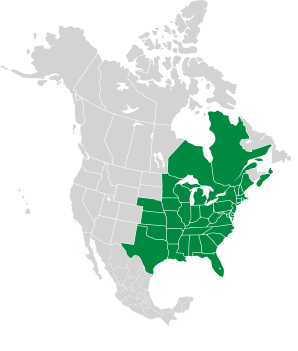Hypericum subpetiolatum E.P. Bicknell ex Small

|
Hypericum punctatum Lam. Spotted St. John’s-wort
Spotted St. John’s-wort is a fairly uncommon North American native plant. It is named for the presence of numerous tiny black spots—glands—on new leaves. This species prefers black soil or gravel prairies, open woodlands, savannas, river and lake banks, railroads, and roadsides. Plants: 5-41″ (13-105 cm) tall, with hairless red or green stems. Stems often branch from the base. Leaves: Leaves are simple (unlobed), hairless, opposite, oblong to oval elliptic, ¾-2″ (1.9-5.7 cm) long × ¼-½″ (8.3-12 mm) wide. New leaves are spotted with tiny black glands. They are typically widest somewhat past the midpoint. Leaves are usually attached to the stem (sessile), but may be on 1/32″ (1 mm) stems (petioles). Leaves turn brilliant reddish purple with age. Flowers: Yellow, five-petaled flowers and densely clustered at stem tips, are ¼-½″ (8-15 mm) around. The sepals, most easily seen enclosing the unopened buds, are also dotted with rows of black dots. At the center of each flower is a round central ovary, from which 3 styles extend, like an inverted tripod. The tip of each style is often red. Surrounding this are more than 13 stamens. Flowers lack a scent, and appear from May to September. Fruits: Upright, ovoid or teardrop-shaped capsule ⅛-¼″ (4-6.3 mm) long, reddish to deep purple. They split into three sections, releasing a lot of tiny seeds. There are several varieties of St. John’s-wort, a few of which are shown below: |
7/15/2019 · Beaver Brook Conservation Area, New Long Loop, Hollis, New Hampshire · ≈ 6 × 4″ (16 × 11 cm) 7/23/2017 · Pine Grove Furnace State Park, Pennsylvania · ≈ 5 × 3½″ (13 × 9.2 cm) 7/15/2019 · Beaver Brook Conservation Area, New Long Loop, Hollis, New Hampshire · ≈ 5 × 3½″ (13 × 9.2 cm) |
||||||||||||||||||||||||||||
|
| |||||||||||||||||||||||||||||
Hypericum ellipticum |
Hypericum mutilum |
Hypericum perforatum |
|||||||||||||||||||||||||||
|---|---|---|---|---|---|---|---|---|---|---|---|---|---|---|---|---|---|---|---|---|---|---|---|---|---|---|---|---|---|
| Common Name |  |
 |
 |
||||||||||||||||||||||||||
| Plant | 8-20″ (20-50 cm) tall. Stems are hairless, somewhat 4-angled.< | 4-18″ (10-45 cm) tall, sometimes up to 2½′ (79 cm), heavily branched, with a shrublike habit. Branches may be 4-angled or smooth, tapering, and sometimes winged. | Less than 3′ (91 cm) in height. | ||||||||||||||||||||||||||
| Flowers | Yellow, in clusters of 1 to a few at stem and branch tips. Each flower is ⅜-½″ (1-1.4 cm) around, with 5 yellow petals and 5 pale green sepals, a fountain of yellow stamens, and three styles fused into one in the center. (Rarely, the number of sepals and petals may be 4 or 6.) There are in excess of 100 stamens. Flowers appear from July to August. | ¼″ (6.3 mm) in size, yellow or yellow-orange, with five petals and 5-15 stamens. Beneath the petals of each flower there are somtimes green bracts that are narrower but roughly the same length, one for each petal. Blooms from July to October. | Bright yellow, star-shaped, with five petals and many yellow stamens about the length of the petals. Petals have serrated edges and small black dots on the serrations. Flowers are up to ⅞″ (2.5 cm) across. | ||||||||||||||||||||||||||
| Leaves | ⅜-1½″ (1-4 cm) × ⅛-¾″ (3-20 mm), and elliptical-oblong in shape, generally rounded at leaf tips, and attached directly to the stem (sessile). | Roughly oval in shape, and attached directly to the stem (sessile). They are opposite, unlobed, ½-1½″ (1.3-3.8 cm) long and ¼-¾″ (6.3-19 mm) across. | Oval, about ⅜″ (1.2 cm) long, with smooth edges, occurring in opposing pairs. | ||||||||||||||||||||||||||
| Fruit | Capsules are ⅛-3/16″ (4-6 mm) × ⅛-3/16″ (3.5-5 mm), ellipsoid, and rounded to a tip. | 1/16-⅛″ (2-3.5 mm) in length. | |||||||||||||||||||||||||||
| Range/ Zones |
|
|
|
||||||||||||||||||||||||||
| Habitats | Sandy forest floodplains, sandy swamps, moist to wed sandy prairies; damp, sandy, acidic areas in general | ||||||||||||||||||||||||||||
| Type | Wild | Wild | Wild | ||||||||||||||||||||||||||
| Occurrence | Common, sometimes invasive | ||||||||||||||||||||||||||||


Online References:
Wildflowers of the United States
7/23/2017 · Pine Grove Furnace State Park, Pennsylvania · ≈ 5 × 3½″ (13 × 9.2 cm) 
7/15/2019 · Beaver Brook Conservation Area, New Long Loop, Hollis, New Hampshire · ≈ 6 × 4″ (14 × 10 cm) 
7/15/2019 · Beaver Brook Conservation Area, New Long Loop, Hollis, New Hampshire · ≈ 6 × 4″ (14 × 10 cm) 
Hypericum subpetiolatum E.P. Bicknell ex Small
Hypericum punctatum description by Thomas H. Kent, last updated 16 Sep 2020.
© FloraFinder.org. All rights reserved.
7/15/2019 · Beaver Brook Conservation Area, New Long Loop, Hollis, New Hampshire · ≈ 6 × 4″ (16 × 11 cm) 
7/23/2017 · Pine Grove Furnace State Park, Pennsylvania · ≈ 4 × 6″ (11 × 16 cm) 
Range:
